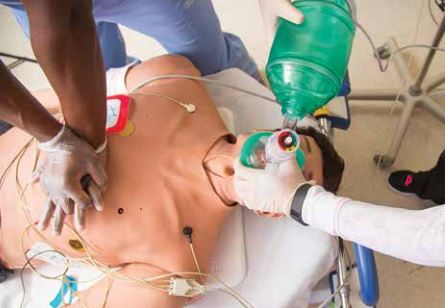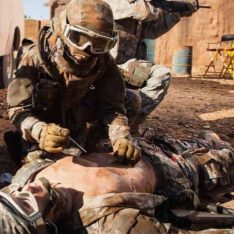The CAE Apollo adult patient simulator boasts a wide range of powerful new features to deliver the ultimate in realistic simulation-based healthcare training. CAE Healthcare’s Apollo retains all the essentials that made METIman the perfect patient manikin, with more powerful performance features and additional configurations to meet both nursing and prehospital learning objectives. With two simulated patient models (prehospital and nursing), Apollo offers the ultimate in versatility and the best value in high fidelity simulation training.
Apollo
CAE Apollo is the fully wireless and tetherless, high-fidelity adult patient simulator with CAE’s modeled physiology.
With two simulated patient configurations (prehospital and nursing), and advanced airway features based on the latest
training protocols, Apollo offers the ultimate in versatility, functionality and lifetime product value.
Built on a platform that has been field-tested and proven by more than 1,600 customers around the world in nursing,
allied healthcare and medical education, the Apollo patient simulator allows learners to practice, gain experience and
develop clinical mastery in a wide range of patient care scenarios. Integrated CPR performance analysis that is compliant
with the American Heart Association’s 2015 guidelines enables learners to obtain procedural training in correct hand
placement, depth, and rate of compressions. Apollo’s inherent mobility gives instructors the added freedom they need to
easily switch from remote tablet to classroom workstation within a single simulation encounter.
Stunningly real aesthetics and powerful training features combine to establish Apollo as the new standard for fidelity in patient simulation.
Airway
• Bag-valve-mask ventilation
• Head tilt/chin lift
• Jaw thrust
• Tongue swelling
• Bronchial occluder
Breathing
• Bilateral and unilateral chest rise and fall
• Spontaneous breathing
• Integrated SpO2 finger probe with
simulated patient monitor
• Breath sounds over entire lungs
• Bilateral chest tube insertion, sensored, with
fluid output
• Pulmonary artery catheter and ability to wedge
the catheter, with display on the waveform
display monitor or a physiologic monitor
Circulation
• Defibrillation and cardioversion using live
defibrillators
• Pacing (use of hands-free pads)
• 12-lead dynamic ECG display
• ECG monitoring posts and interface with
real ECG monitor
• Bilateral blood pressure measurement by
auscultation and palpation
• Bilateral carotid, brachial, radial, femoral,
popliteal, posterior tibia, dorsalis pedis pulses
CPR
• New: CPR analysis that is compliant with
AHA 2015 guidelines
• Adequate chest compressions result in
simulated circulation, cardiac output,
central and peripheral blood pressures,
carbon dioxide return
• Correct hand placement
IV Placement / IO or IM Injections
• Bilateral IV placement sites in antecubital
fossa and dorsum of hand
• IM injection site right deltoid
• Humeral IO site left deltoid
Neurological
• Blinking and reactive eyes with multiple settings
• Convulsions
Gastrointestinal
• Nasogastric tube placement
• Bowel sounds all 4 quadrants
Urinary
• Urinary catheterization
• Interchangeable genitalia
Trauma
• Bleeding and fluid drainage linked to
physiology
• Two simultaneous bleeding/moulage
sites with 1.5 L blood tank capacity
• Limbs can be removed at the knees and
elbows to support amputations
Pharmacology System
• Automatically calculates 68 intravenous
and inhaled medications
• Responses are automatic, dose dependent
and follow appropriate time course
Sounds
• Pre-recorded sounds and speech, custom
vocalization recorded by the user, microphone
• Heart, bowel, and breath sounds (anterior and
posterior) independently controlled (type and
volume)
• Audible breathing sounds (wheezing and
gasping)
Articulation
• Range of motion in the wrists, elbows,
knees and ankles
Prehospital Platform Additional Features
Airway
• Upper airway designed from CT scan data of a
real human patient
• Surgical cricothyrotomy
• Needle cricothyrotomy
• Intubation: orotracheal, nasotracheal, ET tubes,
LMA, retrograde, fiber optic, right mainstem
• Breakaway teeth
• Gastric distention with esophageal intubation
• Laryngospasm
• Airway occluder
• Posterior oropharynx occlusion
Breathing
• Measures the presence or absence of carbon
dioxide exhalation
• Bilateral needle decompression
Secretions
• Eye, nose and mouth
Nursing Platform Additional Features
Airway
• Airway reservoir supports suctioning of
fluids via tracheostomy tube
IV Placement / IO or IM Injections
• Subclavian venous catheter
Gastrointestinal
• Gastric reservoir supports simulated gavage,
lavage and gastric suction
Apollo wireless and tetherless manikin:
available in medium and dark skin tones
Instructor’s workstation with 3 device options
2 Patient platforms to choose from:
Apollo Prehospital and Apollo Nursing
Müse physiologically driven operating
software:
2 Patient profiles
4 Simulated Clinical Experiences (SCEs)
– Anaphylaxis
– Heart failure with pulmonary edema
– Severe young asthmatic
– Subdural hematoma
4 Müse SCE development licenses
Ultrasound Scan Records: normal and
pathologic cases including cardiac,
abdominal, FAST and pleural surface scans
Vïvo instructor driven operating software:
4 Simulated Clinical Experiences (SCEs)
– Anaphylaxis
– Heart failure with pulmonary edema
– Severe young asthmatic
– Subdural hematoma




